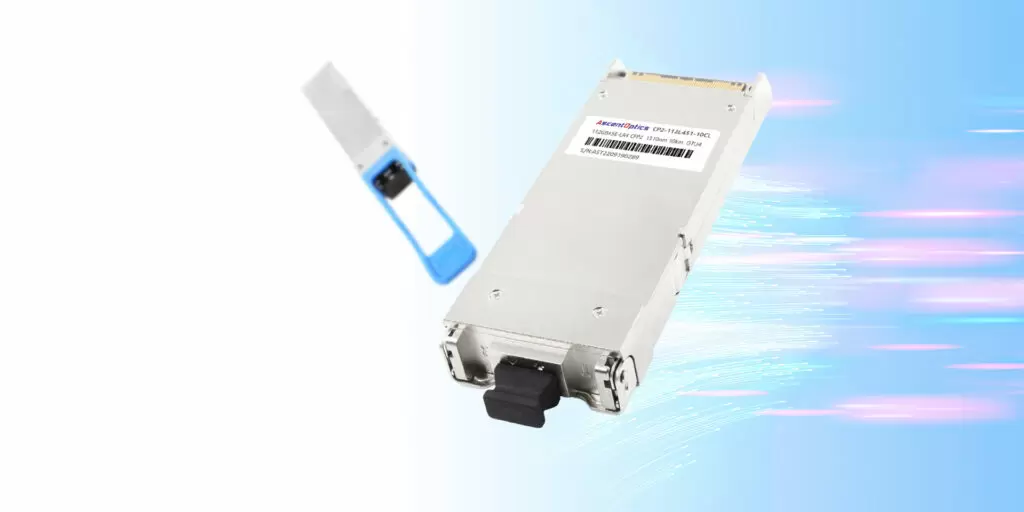With the increasing demand for high-speed and long-distance data transmission, networking technology has advanced to support more efficient and reliable connectivity. The 100GBASE-LR4 optical module has emerged as a crucial solution for long-range data transmission, making it ideal for metro networks, large-scale enterprise infrastructure, and cloud computing applications. Designed for single-mode fiber (SMF), the 100GBASE-LR4 module ensures stable, high-speed communication over extended distances while maintaining efficiency and cost-effectiveness. In this article, we will explore its key features, applications, comparisons with other 100G optical modules, and best practices for selecting the right module for various networking needs.
What is the 100GBASE-LR4 Optical Module?
The 100GBASE-LR4 optical module is a high-speed transceiver that enables 100 Gigabit Ethernet transmission over single-mode fiber. Based on the IEEE 802.3ba standard, it operates using four optical lanes, each transmitting and receiving data at 25Gbps, resulting in a combined data rate of 100Gbps. Unlike the 100GBASE-SR4, which is designed for short-range multimode fiber applications, the LR4 module supports transmission distances of up to 10 kilometers over single-mode fiber, making it ideal for long-haul and metro network deployments. It utilizes wavelength division multiplexing (WDM) technology, transmitting data across four different wavelengths (around 1310nm) and combining them into a single fiber, which enhances efficiency and minimizes fiber usage. The module typically comes in the QSFP28 form factor, ensuring compatibility with a wide range of networking equipment.
Key Features and Benefits
One of the most significant advantages of the 100GBASE-LR4 module is its ability to support long-distance optical transmission while maintaining high-speed connectivity. This makes it an essential solution for data centers, metropolitan networks, and enterprise backbones. Unlike short-range modules that rely on multimode fiber, the LR4 module operates on cost-effective single-mode fiber, which offers lower signal attenuation and higher reliability over extended distances. Another key feature is its use of WDM technology, which allows multiple optical signals to be transmitted simultaneously over a single fiber, reducing fiber consumption and enhancing scalability. Additionally, the module’s low power consumption and thermal efficiency contribute to overall network sustainability and operational cost reduction.
Applications of 100GBASE-LR4 in Networking
The 100GBASE-LR4 module is widely deployed in various networking scenarios that require high-speed, long-distance data transmission. It is a critical component in large-scale data centers, where it connects core routers and aggregation switches across different facilities. Service providers and cloud computing platforms leverage the 100GBASE-LR4 module to establish stable interconnects between data centers, ensuring seamless communication across geographically dispersed locations. In enterprise environments, the LR4 module is used for campus networks and backbone infrastructures, enabling reliable and high-capacity connectivity between different departments and remote offices. Additionally, telecommunication and metro networks utilize the module to support high-bandwidth services for customers, providing efficient long-distance communication without compromising performance.
Comparison with Other 100G Optical Modules
When evaluating the 100GBASE-LR4 module, it is essential to compare it with other 100G optical transceivers to determine its suitability for specific applications. The 100GBASE-SR4 module is designed for short-range connections, typically up to 100 meters over multimode fiber, making it a better fit for intra-data center links rather than long-haul connections. Meanwhile, 100GBASE-ER4 is another long-range module that extends the transmission distance up to 40 kilometers, but it comes at a higher cost due to additional optical amplification requirements. Another alternative is the 100GBASE-CWDM4, which also supports 10 kilometers but uses a different coarse wavelength division multiplexing (CWDM) technology, providing a lower-cost alternative in some scenarios. Choosing the right module depends on factors such as distance, cost, and fiber availability, with the LR4 offering an optimal balance for many long-range networking needs.
Choosing the Right 100GBASE-LR4 Module
Selecting the right 100GBASE-LR4 module requires careful consideration of several factors to ensure seamless integration into an existing network. One of the primary aspects to evaluate is network compatibility, as different hardware vendors may have specific requirements regarding transceiver support. Companies must decide between OEM-branded modules and third-party compatible alternatives, with third-party options often offering cost savings while maintaining quality and performance. Another factor to consider is power efficiency, as optimizing power consumption can reduce operational costs and improve sustainability. Additionally, proper installation and maintenance—such as cleaning fiber connectors and ensuring optimal alignment—are crucial for preventing signal loss and maintaining consistent performance. By addressing these factors, organizations can enhance network reliability and scalability while making cost-effective decisions.
Conclusion
The 100GBASE-LR4 optical module is an essential solution for high-speed, long-distance data transmission, offering superior efficiency and reliability for modern networking infrastructures. With its ability to support up to 10 kilometers over single-mode fiber, utilize WDM technology, and maintain low power consumption, it is an excellent choice for data centers, enterprise networks, and telecom operators. While alternative modules such as 100GBASE-SR4 and 100GBASE-ER4 serve different purposes, the 100GBASE-LR4 remains one of the most versatile and widely adopted long-range transceivers. By carefully selecting the right module and ensuring proper deployment, businesses can achieve high-performance network connectivity that meets the demands of an increasingly digital world. As the need for higher bandwidth and longer transmission distances continues to grow, the role of the 100GBASE-LR4 module will remain critical in advancing next-generation networking solutions.
- The Ultimate Guide To Comfortable Pants for Women: Finding Style for Every Occasion - September 29, 2025
- Understanding the Copper IUD: A Comprehensive Guide to Non-Hormonal Birth Control - August 20, 2025
- The Evolution of Tactical Clothing in Outdoor Adventures - August 19, 2025




